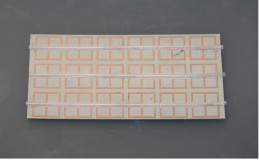‘Metasurface’ tuned with fluid for biomedical sensors
June 9, 2011

NIST's fluid-tunable "metasurface" consists of copper structures and plastic tubing mounted on composite board. The presence of water in the tubing changes the resonant frequency at which the metasurface absorbs and stores energy (credit: NIST)
Researchers at the National Institute of Standards and Technology (NIST) have demonstrated a unique fluid-tuned “metasurface,” a concept that may be useful in biomedical sensors and microwave-assisted chemistry.
NIST researchers used purified water to tune the metasurface’s resonant frequency: the specific microwave frequency at which the surface can accumulate or store energy. They also calculated that the metasurface could concentrate electric field strength in localized areas, and thus might be used to heat fluids and promote microwave-assisted chemical or biochemical reactions.
The metasurface’s behavior is due to interactions of 18 square copper frame structures, each 10 millimeters on a side. Computer simulations helped design the copper squares to respond to a specific frequency.
The researchers tested the metasurface properties with and without purified water in the fluid channels. The presence of water shifted the resonant frequency from 3.75 to 3.60 gigahertz. At other frequencies, the metasurface reflected or transmitted energy. The researchers calculated that the metasurface, when in the resonant condition, could concentrate energy in the gaps at least 100 times more than the waveguide alone.
The researchers are also looking into the possibility of making metamaterial chips or circuits to use for biomedical applications such as counting cells.
Ref.: J. Gordon, et al., Fluid interactions with metafilm/metasurfaces for tuning, sensing, and microwave assisted chemical processes, Physical Review B, 83, 205130 (2011) [DOI: 10.1103/PhysRevB.83.205130]